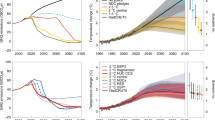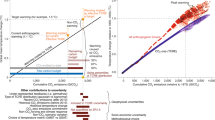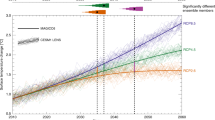Abstract
Long-term future warming is primarily constrained by cumulative emissions of carbon dioxide1,2,3,4. Previous studies have estimated that humankind has already emitted about 50% of the total amount allowed if warming, relative to pre-industrial, is to stay below 2 °C (refs 1, 2). Carbon dioxide emissions will thus need to decrease substantially in the future if this target is to be met. Here we show how links between near-term decisions, long-term behaviour and climate sensitivity uncertainties constrain options for emissions mitigation. Using a model of intermediate complexity5,6, we explore the implications of non-zero long-term global emissions, combined with various near-term mitigation rates or delays in action. For a median climate sensitivity, a long-term 90% emission reduction relative to the present-day level is incompatible with a 2 °C target within the coming millennium. Zero or negative emissions can be compatible with the target if medium to high emission-reduction rates begin within the next two decades. For a high climate sensitivity, however, even negative emissions would require a global mitigation rate at least as great as the highest rate considered feasible by economic models7,8 to be implemented within the coming decade. Only a low climate sensitivity would allow for a longer delay in mitigation action and a more conservative mitigation rate, and would still require at least 90% phase-out of emissions thereafter.
This is a preview of subscription content, access via your institution
Access options
Subscribe to this journal
Receive 12 print issues and online access
$209.00 per year
only $17.42 per issue
Buy this article
- Purchase on Springer Link
- Instant access to full article PDF
Prices may be subject to local taxes which are calculated during checkout



Similar content being viewed by others
References
Allen, M. et al. Warming caused by cumulative carbon emissions towards the trillionth tonne. Nature 458, 1163–1166 (2009).
Zickfeld, K., Eby, M., Matthews, H. D. & Weaver, A. J. Setting cumulative emissions targets to reduce the risk of dangerous climate change. Proc. Natl Acad. Sci. USA 106, 16129–16134 (2010).
Matthews, H. D., Gillett, N. P., Stott, P. A. & Zickfeld, K. The proportionality of global warming to cumulative carbon emissions. Nature 459, 829–832 (2009).
Raupach, M. R. et al. The relationship between peak warming and cumulative CO2 emissions, and its use to quantify vulnerabilities in the carbon-climate-human system. Tellus B 63, 145–164 (2011).
Stocker, T. F., Wright, D. G. & Mysak, L. A. A zonally averaged, coupled ocean-atmosphere model for paleoclimate studies. J. Clim. 5, 773–797 (1992).
Joos, F., Plattner, G-K., Stocker, T. F., Marchal, O. & Schmittner, A. Global warming and marine carbon cycle feedbacks on future atmospheric CO2 . Science 284, 464–467 (1999).
UNEP The Emissions Gap Report: Are the Copenhagen Accord Pledges Sufficient to Limit Global Warming to 2 °C or 1.5 °C? (UNEP, 2010); available at http://www.unep.org/publications/ebooks/emissionsgapreport/.
den Elzen, M. G. J., van Vuuren, D. P. & van Vliet, J. Postponing emission reductions from 2020 to 2030 increases climate risks and long-term costs. Climatic Change 99, 313–320 (2010).
UNFCCC, Communications Received from Parties in Relation to the Listing in the Chapeau of the Copenhagen Accord (UNFCCC, 2010); available at http://unfccc.int/meetings/cop_15/copenhagen_accord/items/5276.php.
Friedlingstein, P. et al. Update on CO2 emissions. Nature Geosci. 3, 811–812 (2010).
Hegerl, G. C. et al. in IPCC Climate Change 2007: The Physical Science Basis (eds Solomon, S. et al.) 663–745 (Cambridge Univ. Press, 2007).
Hourcade, J-C. & Crassous, R. Low-carbon societies: A challenging transition for an attractive future. Clim. Policy 8, 607–612 (2008).
Van Vuuren, D. P. et al. Stabilizing greenhouse gas concentrations at low levels: An assessment of reduction strategies and costs. Climatic Change 81, 119–159 (2007).
Van Vuuren, D. P., Bellevrat, E., Kitous, A. & Isaac, M. Bio-energy use and low stabilization scenarios. Energy J. 31, 193–222 (2010).
Van Vuuren, D. P. et al. RCP2.6: Exploring the possibility to keep global mean temperature change below 2 °C. Climatic Change 109, 95–116 (2011).
Edenhofer, O. et al. The economics of low stabilization: Model comparison of mitigation strategies and costs. Energy J. 31, 11–48 (2010).
Clarke, L. et al. International climate policy architectures: Overview of the EMF 22 international scenarios. Energy Econ. 31, S64–S81 (2009).
Edmonds, J., Clarke, L., Lurz, J. & Wise, M. Stabilizing CO2 concentrations with incomplete international cooperation. Clim. Policy 8, 355–376 (2008).
Richels, R., Blanford, G. J. & Rutherford, T. F. International climate policy: A ‘second best’ solution for a ‘second best’ world? Climatic Change 97, 289–296 (2009).
Davis, S. J., Caldeira, K. & Matthews, H. D. Future CO2 emissions and climate change from existing energy infrastructure. Science 329, 1330–1333 (2010).
Bosetti, V., Carraro, C. & Tavoni, M. Climate change mitigation strategies in fast-growing countries: The benefits of early action. Energy Econ. 31, S144–S151 (2009).
Weaver, A. J., Zickfeld, K., Montenegro, A. & Eby, M. Long term climate implications of 2050 emission reduction targets. Geophys. Res. Lett. 34, L19703 (2007).
Meehl, G. A. et al. in IPCC Climate Change 2007: The Physical Science Basis (eds Solomon, S. et al.) 747–845 (Cambridge Univ. Press, 2007).
Solomon, S., Plattner, G-K., Knutti, R. & Friedlingstein, P. Irreversible climate change due to carbon dioxide emissions. Proc. Natl Acad. Sci. USA 106, 1074–1079 (2009).
Solomon, et al. Persistence of climate changes due to a range of greenhouse gases. Proc. Natl Acad. Sci. USA 107, 18354–18359 (2010).
Knutti, R. & Hegerl, G. C. The equilibrium sensitivity of the Earth’s temperature to radiation changes. Nature Geosci. 1, 735–743 (2008).
Lunt, D. J. et al. Earth system sensitivity inferred from Pliocene modeling and data. Nature Geosci. 3, 60–64 (2010).
Marchal, O., Stocker, T. F. & Joos, F. A latitude-depth circulation-biogeochemical ocean model for paleoclimate studies. Model development and sensitivity. Tellus B 50, 290–316 (1998).
Siegenthaler, U. & Oeschger, H. Biospheric CO2 emissions during the past 200 years reconstructed by convolution of ice core data. Tellus B 39, 140–154 (1987).
Archer, D. Fate of fossil fuel CO2 in geologic time. J. Geophys. Res. 110, C09S05 (2005).
Friedlingstein, P. et al. Climate-carbon cycle feedback analysis: Results from the C4MIP model intercomparison. J. Clim. 19, 3337–3353 (2006).
Gregory, J. M., Jones, C. D., Cadule, P. & Friedlingstein, P. Quantifying carbon cycle feedbacks. J. Clim. 22, 5232–5250 (2009).
Knutti, R., Stocker, T. F., Joos, F. & Plattner, G-K. Probabilistic climate change projections using neural networks. Clim. Dyn. 21, 257–272 (2003).
Acknowledgements
The authors wish to thank D. Matthews, J. Daniel and T. Sanford for helpful discussions and R. Flecker for creating Fig. 3.
Author information
Authors and Affiliations
Contributions
P.F. and S.S. designed the work and the experiments, P.F. performed the model simulations, G-K.P. provided the model code, G-K.P. and R.K. gave guidance on the use of the model, P.F. led the writing of the paper with contributions from all other authors.
Corresponding author
Ethics declarations
Competing interests
The authors declare no competing financial interests.
Supplementary information
Rights and permissions
About this article
Cite this article
Friedlingstein, P., Solomon, S., Plattner, GK. et al. Long-term climate implications of twenty-first century options for carbon dioxide emission mitigation. Nature Clim Change 1, 457–461 (2011). https://doi.org/10.1038/nclimate1302
Received:
Accepted:
Published:
Issue Date:
DOI: https://doi.org/10.1038/nclimate1302
This article is cited by
-
Long-Term Climate Treaties with a Refunding Club
Environmental and Resource Economics (2021)
-
Carbon Nanomaterials for the Treatment of Heavy Metal-Contaminated Water and Environmental Remediation
Nanoscale Research Letters (2019)
-
Mitigating global warming: a real options approach
Annals of Operations Research (2017)
-
Consequences of twenty-first-century policy for multi-millennial climate and sea-level change
Nature Climate Change (2016)
-
Encapsulated liquid sorbents for carbon dioxide capture
Nature Communications (2015)



